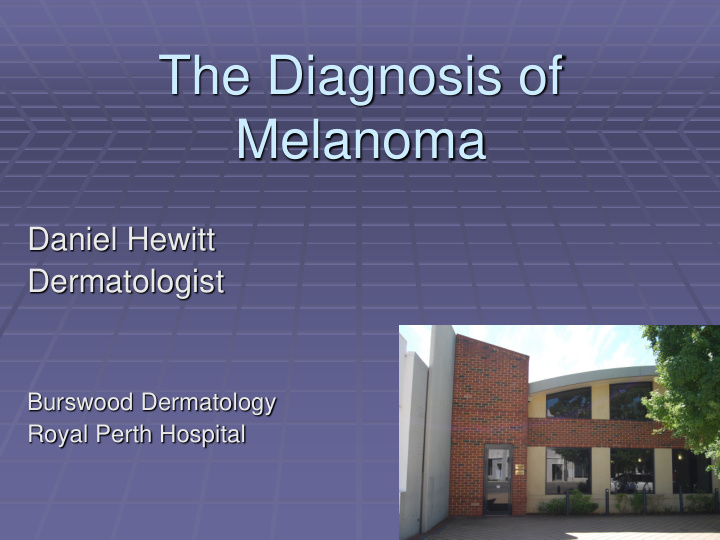



The Diagnosis of Melanoma Daniel Hewitt Dermatologist Burswood Dermatology Royal Perth Hospital
A personal approach To not miss melanoma To accurately diagnose melanoma as early as possible This will lack detail in… Clinical features of melanoma Dermatoscopic features of melanoma Epidemiology of melanoma
Know yourself 1 Know the features of melanoma 2 Know your limitations Know your patient 3 Understand the important risk factors 4 Assess the individual 5 Examine properly 6 Biopsy appropriately
1 Know the features of melanoma
ABCDE of Melanoma A - ASYMMETRY ; one half unlike the other half. B - BORDER ; irregular, scalloped or poorly defined border. C - COLOUR ; varied from one area to another; shades of tan, brown, and black; sometimes white, red, or blue. D - DIAMETER ; melanomas are usually greater than 6mm when diagnosed, but they can be smaller. E - EVOLVING ; a mole or skin lesion that looks different from the rest or is changing in size, shape, or colour.
Many clinical subtypes.. Superficial spreading melanoma (SSM) Nodular melanoma (NM) Lentigo maligna (LM) & lentigo maligna melanoma (LMM) Desmoplastic melanoma Acral lentiginous melanoma (ALM) Subungual melanoma
15% of melanomas present with an expansile nodule - features can be summarized using: E levated F irm G rowing
Beware the ugly duckling
Significant change over 3 months is the key Melanomas either grow from preceding melanocytic lesions or grow as new lesions
2 Know when you can’t make a diagnosis If you are not sure biopsy or refer Err on the side of caution
3 Understand the important risk factors Personal history of melanoma Immediate family history of melanoma Dysplastic naevus syndrome Immunosuppression History of numerous sunburns
4 Assess the individual Some patients do know their skin
Others do not – these need a more paternalistic approach
5 Examine properly Light, magnification Enitre skin surface
“A total of 94 melanomas were detected during this 12-month period. Of these, 57 (60.6%) were incidentally detected by the dermatologist.” Cherian P; Tait C. Melanoma in private practice: do Dermatologists make a difference?. Australasian Journal of Dermatology. 50(4):257-60, 2009 Nov.
6 Biopsy appropriately Excisional biopsy with narrow margin Large incisional biopsy if excision not possible Shave biopsy in special circumstances
Do not punch biopsy Melanocytic hyperplasia = melanoma
Know yourself 1 Know the features of melanoma 2 Know your limitations Know your patient 3 Understand the important risk factors 4 Assess the individual 5 Examine properly 6 Biopsy appropriately
Recommend
More recommend